PART 2

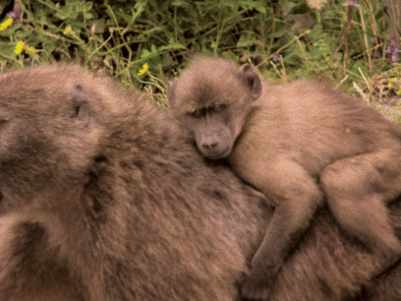
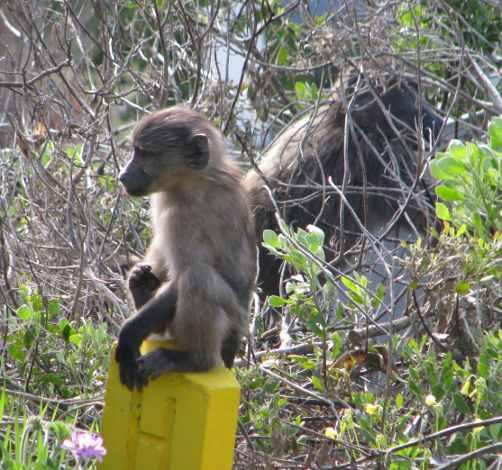
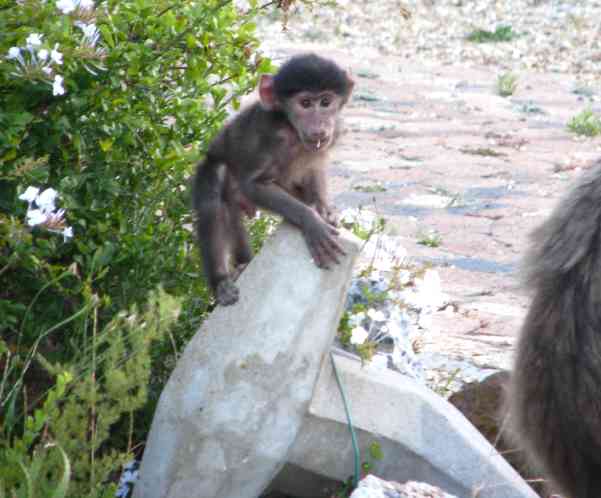
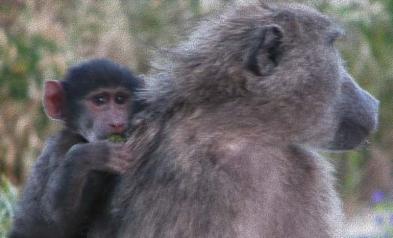
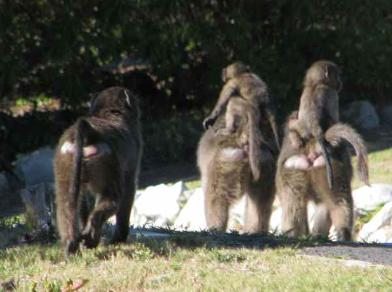
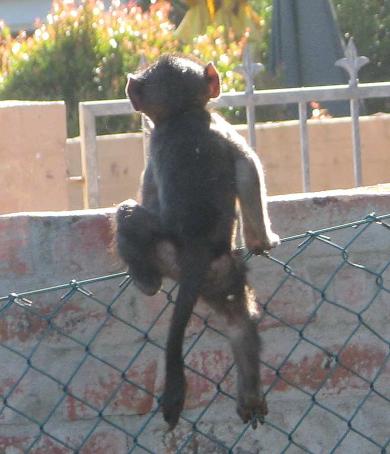
Small baboons in a residential area. While calling for baboons to be culled or killed, or aggressive means like bearbangers and bullwhips to be used, some have focused on the male baboons, attempting to portray them as "increasingly aggressive" and "a potential threat to safety", overlooking the fact that the troop comprises mostly females and easily traumatised young and that the males play a vital role in the troop and their "removal" cause troop disruption.
A BLG sponsored article in Full Circle magazine in October 2011 likened baboons to bears and advocated a community approach and adopting adversive conditioning methods as used by experts in bear management - rubber bullets, fireworks and pepper spray. The SPCA and NSPCA have censured bullwhips and bearbangers.
Note the size difference of baboons to bears. Adult male black bears can weigh up to 225 kgs, Brown bears of coastal Alaska may weigh up to 450 kgs. A large adult male chacma baboon may weigh up to 40 kgs (twice the weight of an adult female.) As can be seen above the troop consists of young baboons weighing far less.
Unlike bears baboons are not predators of man.
In the same month it was reported that NCC planned to provide monitors with paintball marker training, another proposal that has drawn outrage. (They were observed being used in the Constantia area by Mark Duffel who had been involved in the original Simonstown bearbanger and bullwhip experiment in June 2009. Aside from possible injury, using aggressive tools sends the wrong message to some residents that they may use them too.)
Whistles and shouts work well at moving the baboons, if and when used in the monitoring situation. Unfortunately these methods have been de-emphasized.

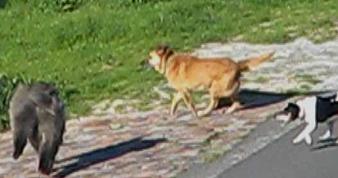
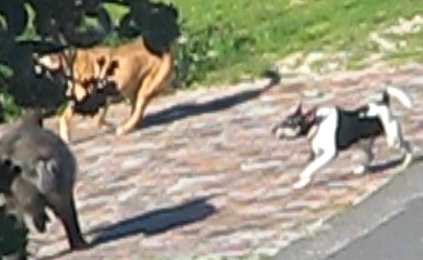
A sub adult baboon attempts to shield a juvenile from an advancing dog. Two dogs outside property chase adult male baboon previously walking down the street. Baboons are regularly injured
or killed by dogs. While some say baboons have no natural predators in
the urban area i.e. the leopard - dogs and man may prove deadly for baboons in the urban setting. George, the former alpha male of the Da Gama troop was killed by two dogs in October 2011.

Young baboon in residential area. Baboons are sensitive animals, easily traumatised as has been demonstrated when they have been terrified during the repeated attempts of introduction of bullwhips and bearbangers at various times during new management. There have been objections by the SPCA and NSPCA against these methods. Baboons can be chased off residential properties using a direct jet of water from the hose pipe.
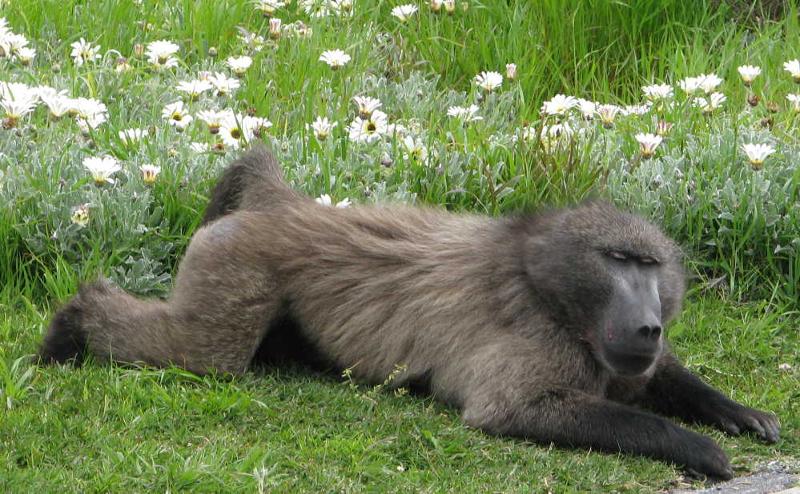
Adult male baboon, Sebastian, rests on pavement. Signs of injuries from dominance fighting are visible on his face. Injuries can be far more serious. Currently, vets are not mandated to treat baboon on baboon injuries. Dominance fighting among males occurs in the hierarchically structured chacma baboon troop. and may mean a male has to leave the troop temporarily until fighting subsides or even attempt to move to another troop. The 2009 dispersing male and repeat raider protocol targets these animals in particular if leaving the troop. Sebastian dispersed from the Tokai troop by himself and joined a troop in the Welcome Glen area.

Quizzy, Noskethi, George
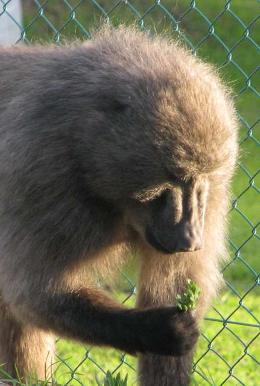
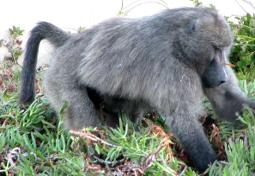
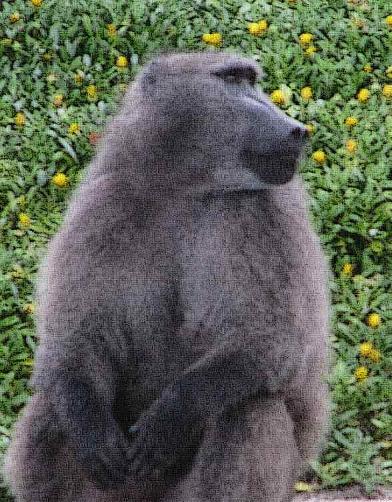
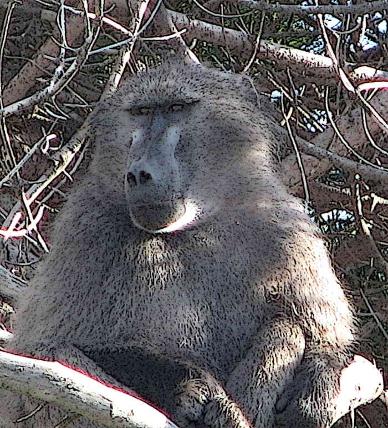
Adult male baboons. A mature male weighs from 30-40kg, females 15-20 kg and juveniles and babies are much smaller.
While any baboon could be classified as a repeat raider if food is repeatedly made available, males were specifically targeted by the "dispersing male" protocol of August 2009 headed "prepared by BRU" as well as the "individual raider" protocol of June 2010.
According to the first dispersing male and repeat raider protocol, if leaving their troop and coming into the urban area (which means they could well raid unsecured properties), baboons may be killed from the 2nd to 4th capture after initial ear-tagging.
Under a heading of “reducing numbers” the head of BRU gave a presentation that listed “selective removal” (a definition of “culling”) of whole troops and various sex and age categories.
Despite baboons being killed under its terms, some like BRU and members of the BLG of which BRU is a founding member continue to deny baboons have been "culled", choosing the word "euthanize". It creates an incorrect impression when claiming no baboons have been "culled" whereas a number have been killed.
A number of males have already been ear-tagged, defined as the first step in the culling process in the 2009 protocol. (Since 2011, females and males are being eartagged with different looking tags ostensibly for a cross transmission of diseases screening programme.)
Some baboons, like Sol, were killed following some Simonstown residents' complaints. In Sol's case, his culling (beginning of January 2010) was not made public at the time.
William was killed following a Scarborough residents' complaint that he had entered property and "traumatised" them. Another resident who was out of the country much of the time also made a complaint about him.
Fred, originally also in the Simonstown area, was killed in 2011 for opening car doors along in the Miller's Point/Smitswinkel area and raiding. There were also service provider complaints that he was acting "aggressively" towards monitors and a field manager when attempting to mitigate raids. (A couple of months later, similar claims would be made against another troop member, a "grandfather" of the troop Merlin who would also open car doors in search of food.)
However, others point out that monitors and field managers are not receiving proper or sufficient training in how to handle the baboons in a monitoring situation nor are taught how to assert proper dominance in that situation rather than being either passive or aggressive towards the baboons. (It is possible that aggressive rather than assertive handling methods could also provoke negative reactions from the male baboons.) Baboon Matters has repeatedly offered to help train the monitors and field managers - something that would benefit monitoring staff, residents and the baboons.
Some residents have long been totally opposed to baboons ever entering urban areas, despite the fact that their home ranges may be intersected by urban development. Aside from baboons' natural proclivity to eat available food, given that monitors and field managers are in need of training in handling the baboons, and may even provoke aggressive responses due to lack of skills, there are concerns more baboons, particularly the males, will continue to be targeted by implementation of the protocols.
In June 2010, another protocol was introduced targeting individual raiders, once again illustrating the baboons' protected status has attempted to be over-ridden. By declaring them "raiders" or damage causing animals, they are now categorised in the same way they are regarded in the rest of the country - damage causing animals i.e. vermin that can be killed.
On 15 July, 2011 Jimmy, another Simonstown area baboon was killed – 3 of the known 5 males culled have been in this area at the time of culling. The Wildlife Advisory Committee, with the evidence put before them, also gave permission for a Tokai baboon, TK8, or Oswald to be killed.
At a meeting convened by the City for residents of Da Gama Park, the City's representative of the Baboon Conservation Authority, Julia Wood said:""They will go through a system and if they are found to be physically dangerous and that they are raiding excessively and we cannot do anything with them, we cannot translocate them, we will look towards euthanasing them. That's part of the way we are managing the baboon population at the moment. It's probably not enough you know, we should probably be taking out more males in a situation like this but our constraints are and we have to make sure that we do it in a logical way and that the thought processes and the information goes through and CapeNature makes the decision. We don't make that decision."
Names for the baboons are being phased out, replaced only by numbers, making it more difficult for the public to keep track of baboons. The reason given by the City vet is that it is "more scientific, less emotional" when "difficult decisions have to be made".
To date access to information, including statistical information, such as the number of males relocated is being withheld by the research unit from members of the public. The June 2010 protocol was only released in the public domain in November 2011.
Baboons are also tagged ostensibly for human-baboon disease transmission research purposes since around April 2011. Given that the unit did say in 2009 that disease transmission was a reason for culling, some are concerned that with the research unit's involvement and influence, the focus has moved towards the Peninsula's free-ranging baboons becoming an "open air laboratory" with too much emphasis on research rather than sufficient emphasis being paid to their conservation.
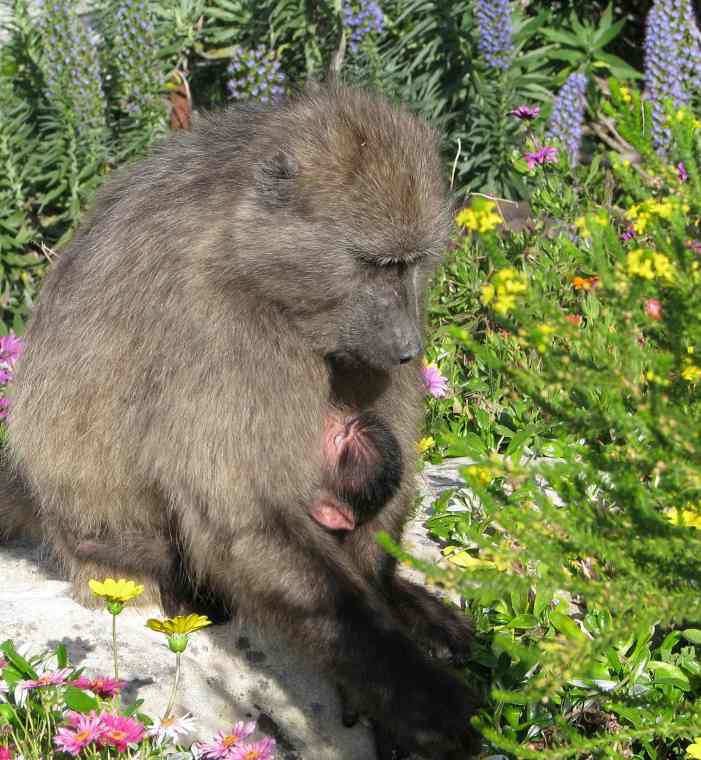
Female baboon {Tammy} with baby. Her leg was amputated after she was shot, shattering the femur.
There have been a number of other amputees within the troop as a result of residents' traps, bullets and pellets, testimony to the cruel actions taken by some against baboons, vulnerable and trusting of humans as they pass through the areas they once roamed freely.
Some deny baboons were in the area previously in an attempt to motivate for their removal, yet Cape Chacma baboons are indigenous to the Cape and were there since before human settlement written complaints of baboons raiding go back to early settlers in the 17th century, nothing has changed although some now claim that baboons are increasingly aggressive in order to agitate for their removal. There are anecdotal and documented reports half a century ago showing human-baboon interaction along the route to Cape Point. Human-baboon interaction is not something new, as some residents claim to motivate for baboon removal.
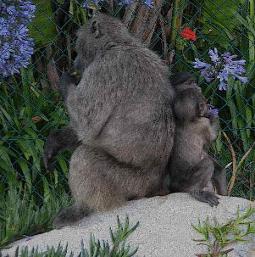

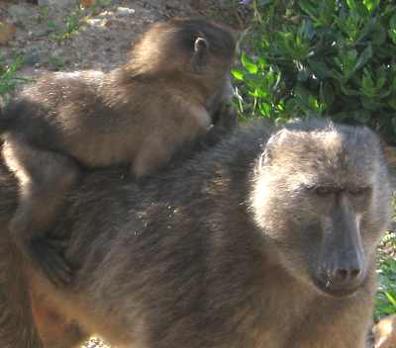
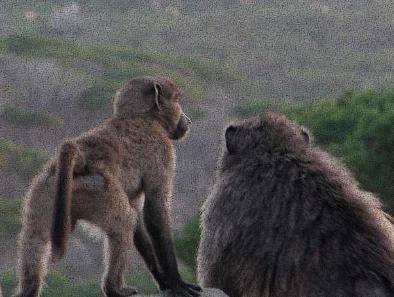
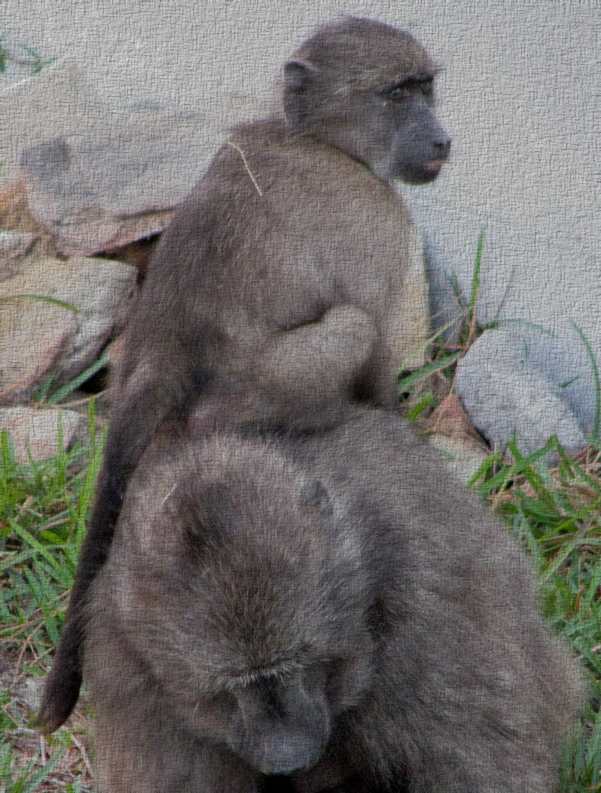
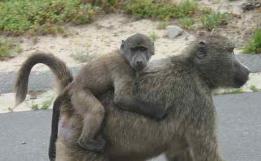
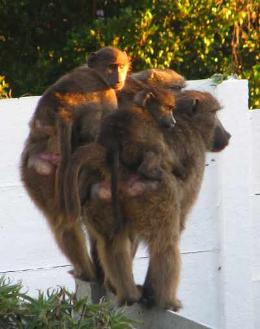
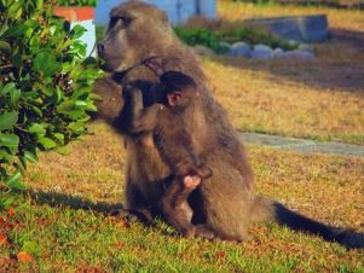
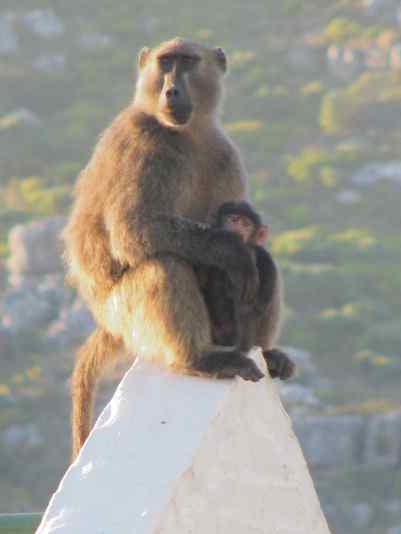
Adult females and babies in residential area. Females and youngster do not have the long canines of the males. In nature, these are used by males in dominance fighting to establish their place in the troop structure as well as serving as defense against their natural predator, the leopard.
Despite the long canines of adult male baboons leading some to believe they are carnivores like lions and leopards and thus pose a similar threat to human safety, baboons are mostly vegetarian and are not considered by experts as highly dangerous to man. They are not predators.
However, do not to put yourself in a situation where they could feel cornered or threatened and do not attempt to touch them or their young. Do not attempt to grab food or a bag which they may think contains food as they will attempt to retain it.
A new regulation was gazetted in the Western Cape in 2011 making it illegal to feed baboons in any private or public space. The previous law made it illegal to feed baboons along roads.
Potential confrontation related to food is avoided by not making food available.
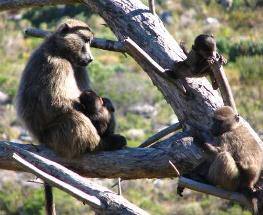

Female baboons and young sit in a tree in their home range.

Adult male baboon {Sebastian} stands amidst the lavender on a residential pavement.
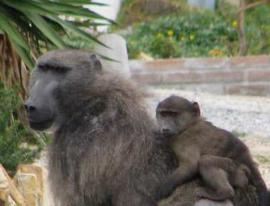

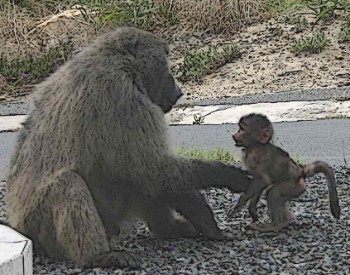
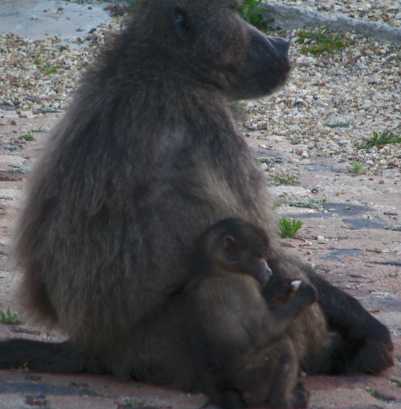
Adult male Chacma baboons with babies. {Quizzy,George,Peter} Chacma baboons use a number of different vocalizations to communicate. Males communicate with reassuring grunts as a baby approaches.
An important role of males within the troop is to protect the females and young. Their reaction when a baby squeals is instantaneous, ready to come to its defense. Visitors should therefore never attempt to touch baboons.
The Chacma baboon troop is hierarchically structured with an Alpha male being the dominant leader. Males fight to establish dominance in this structure. Fighting may precipitate them leaving the troop either temporarily or permanently to start their own troop or seek to join another. They may leave the troop a number of times during their life.
Females are also hierarchically ranked but inherit their ranking from their mother. Unless they leave the troop with a dispersing male to form a "fission" troop, splitting from the old, they generally stay with the troop for life.
Male baboons play a protective role in the troop, also important in free-ranging baboons. Alpha males may help carry the babies on their backs or underbelly at times. They maintain order in the troop, sorting out squabbles amongst troop members..
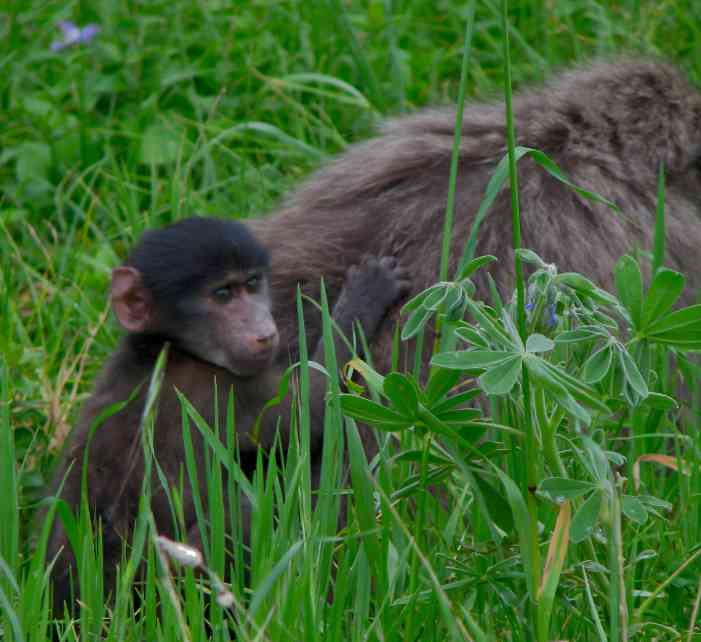
Baby rides on mother's back. The bond between the mother and her youngster is strong. Females carry their dead youngsters around for days, mourning their loss.
Since July 2009, the baboons are not only threatened by the actions of some residents, they are faced with new management strategies, including implementation of culling for raiding.
A tender put out for a new management contract starting in February 2009-30-June 2010 called for quotes per month for removal, relocation and/or euthanizing of dispersing males. Regardless of the actual quantity listed in the tender, the fact that any baboons of this small and endangered population remaining at not much more than 350 over the last decade, are under consideration for culling for coming into the urban area or eating available food is of concern, also given that the protocol appears to attempt to remove their protected status, with baboons now being killed for the very same reasons as in the rest of the country where they have been considered as vermin, problem or damage causing animals.
Most of the baboons in a troop consist of the much smaller females and the young that are sensitive and easily traumatized, a reason potentially aggressive monitoring methods such as whips and bear bangers are unacceptable. During attempts at introducing bear bangers and bullwhips near residential areas, residents have complained about their own pets being traumatized by the sound - without even being directly exposed to them as the baboons would be.
The June 2010 protocol targets baboons for various reasons other than raiding. Quickly dubbed a "secret protocol", the protocol was not available to the public, with some officials including the vet who administered the lethal dart to William, the first baboon killed under its terms, saying it could be used against the baboons. (Two residents did indeed give affadavits regarding him, claiming to have been "traumatized". One resident was out of the country much of the time.)
In November 2011 the protocol was placed on the CapeNature website.
All Content by site author Copyright 2009-2011
All Rights reserved L Thomas
No portion of content may be reproduced in any way without written permission
Individual Rights apply to FLICKR photos